
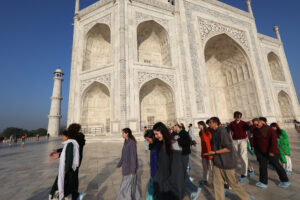
Today we had the opportunity to visit the Taj Mahal in the early morning. My classmate Peter and I woke up at 5:15am in order to meet with the group in the lobby at 5:25am. Once we arrived at the Taj Mahal, we got off our bus and onto other vehicles that were like extended golf carts. These extended golf carts took us to the entrance to the Taj Mahal, where we then had to wait in line for roughly 40 minutes. The cause for the long wait was partly because it was not open yet and also because the security checkpoint was slow. By the time we all made it through security it was around 7:30am.
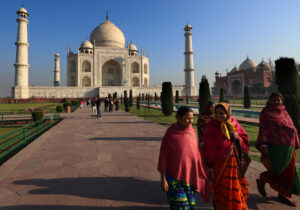
Before getting to the actual Taj Mahal, you get to the Taj Mahal Courtyard which is a large square shaped area that has a huge gate that leads to the Taj Mahal. Up until that point, you could only see the very top of the Taj Mahal, so there is a lot of built up anticipation as you walk through the gate. Normally, I am not easily impressed by architecture and buildings, but the Taj Mahal was one of the few buildings that did impress me. Not only is it massive and so much to take in from afar, but when you get closer you see all the fine details that were put into the building and it is even more spectacular. Not only are the paint patterns all along the walls and ceilings eye-catching and captivating, there are also hand carved shapes in the marble all around the Taj Mahal which are even more impressive.
During our visit our guide, Shantum, gave us some history on the Taj Mahal and there were a few things that I found intriguing. First, he explained that the Taj Mahal actually isn’t solid marble, but that it is instead built out of bricks and then was covered with a marble coating. The place from which the workers got the marble was roughly 300 kilometers away, so the fifth Mughal emperor, Shah Jahan who built the Taj Mahal for this third and favorite wife, also had to have roads built to the quarry. In total, about 22,000 people helped build the Taj Mahal and it took them 22 years to do so. The actual building was done after a little less than a decade, but all the decorations and the gardens took a lot more time to build. It is quite an impressive building to entomb and profess his undying love to his wife. As the story goes, as she was dying giving birth to their 14th child, she asked him to build something as beautiful as their love.

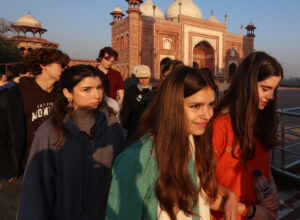
At 5:00 am, our alarm sounded, waking me up for what I didn’t know was going to be the most awe-inspiring day of the trip. The Taj Mahal has been an icon representing India for me, all of my life. I have seen it everywhere, on posters in my elementary school classroom as well as in books, but I had never once thought that I would be looking at it in person, let alone standing inside of this amazing work of art. Before we could see the Taj Mahal, we had to go through the impressive main gate. It has gorgeous detailing within the red sandstone from which it is made, with flowers made of 60 pieces of semi-precious stones each lining the gate, creating a beautiful frame. Around this, a calligraphic inscription is engraved. It reads, “O soul, you are at rest. Return to the Lord in peace with him, and he at peace with you.” Shantum, our leader for the day, explained that as we walk through the gate, we leave everything in the world behind and enter, focusing only on the present. Walking through the gate was an incredible experience. The shape of it perfectly framed the Taj Mahal, which was a long distance away, but it seemed closer than it appeared. Shantum had mentioned that there were some optical illusions that the gate created; for example, if you started walking backward in the gate, it would look like the Taj Mahal was moving toward you. Outside the gate, beautiful gardens were waiting for us in the dim morning light. A long strip of water ran through the middle of the area, leading up to the Taj Mahal. I took a moment to center myself and listened to the morning birds singing. Looking out at the Taj Mahal, I could not believe that it was real. A breathtaking ombré of colors created the perfect backdrop for the stunning Taj Mahal.
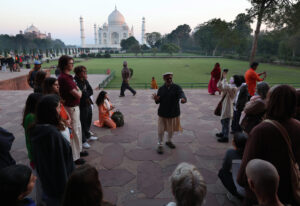
Shantum had wanted us to go early in the morning so that we could see how the sunrise changed the whole aura of the place, and he was correct. As the sun rose, light reflected off of the marble dome of the Taj Mahal. The sky turned blue and more people came filing in. Here, I learned a few of the architectural decisions that were made. Shantum explained to us how the sun frames the Taj Mahal, which faces south. Looking at it from the front, the sun goes around the building each day, changing its appearance every hour of the day. I also learned from my teacher Chelsea that the two closest columns on the side of the main building were slightly tilted out on purpose to look more straight and so that if there were an earthquake, they would fall out and not destroy the building. The inside of the Taj Mahal was just as beautiful as the outside. There were flower engravings everywhere, as well as the same flowers that were on the main gate. In the middle of the room, two marble caskets with beautiful detailing were surrounded by a marble gate. One side was open so I could see through. The one in the middle was for a man’s wife, which is who he designed it for. The second casket was off to the side because it belonged to him. The acoustics inside were amazing. Although speaking was not allowed, many people were talking and I could hear the riveting echoes throughout the building.
I now understand why the Taj Mahal is considered one of the wonders of the world. Its beauty surpasses many places that I have been to, and the feelings you get when you are there are indescribable.

On Wednesday night, our class arrived at a hotel in Agra, where we were greeted by Shantum, one of our tour guides. As we gathered before dinner, Shantum outlined the plans for the following day, including an early morning visit to the Taj Mahal.
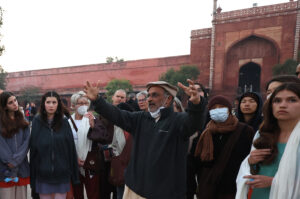
The next morning, my roommate Sophia and I rose early, meeting the group in the lobby at 5:30 AM as planned. Walking to the bus while it was still dark out had a sort of auspicious feeling, amplified by our teacher Shannon’s encouraging words: “the early bird gets the worm.”
Upon arriving at the Taj Mahal, I felt extremely tired having woken up at 4:30 AM to see the sunrise. Standing in the long line for security increased the anticipation of laying eyes on a marvelous sight that everyone speaks so highly of.
Guided by Shantum, a man of spiritual insight, we were encouraged to pause as we walked through the entrance that framed the Taj Mahal and take a few steps back. He explained that by stepping back, we could imagine the Taj Mahal coming to us rather than us coming to it. This spiritual approach heightened my appreciation as I beheld the majestic beauty of the Taj Mahal.
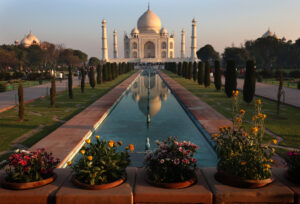
Shantum’s explanation of the Taj Mahal’s architecture, crafted from pristine white marble adorned with intricately carved and inlaid flowers, was mesmerizing. Learning that the designs were not painted but precisely fashioned from colored stones like sapphire and malachite made me feel even more astonished.
Venturing inside, I marveled at the intricate floral patterns, each petal made with around 60 individual crystal pieces. This attention to detail left me in absolute awe.
My visit to the Taj Mahal deepened my fascination with architecture and design. Its sheer dedication and expression of love through architecture left a huge impression, reaffirming its status as a timeless masterpiece. There was a mystical allure that captivated me in a way that surprised me. Its history, dating back to 1631 when the Mughal emperor Shah Jahan built it for his beloved wife Mumtaz Mahal, feels like a plot from a movie script. I was intrigued. There are no words to describe how I felt when I saw the Taj Mahal. My fascination with it runs deeper than I thought it would. The Taj Mahal, made from intense dedication and love, is unique and magical.
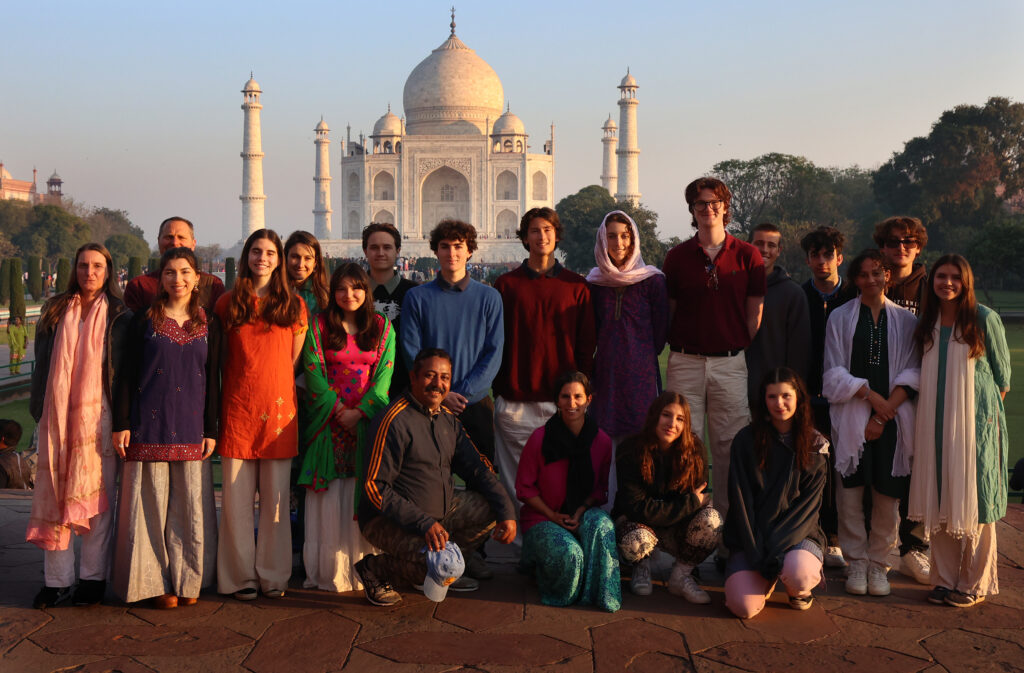
Talks with a Monk

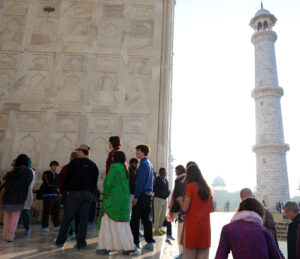
Today, we went very early in the morning to visit the Taj Mahal in Agra. My class and I were accompanied by a friend of Shannon (my teacher), whose name is Shantum Seth. Shantum was in Agra to meet with us but also to give a Buddhist tour of India to a group of people. The group was made up of people with many different backgrounds, some of whom were monks. As we walked around the Taj Mahal, taking in all its glory, I started to wonder why someone would decide to be a monk. So, I asked one of the monks from Shantum’s group what drew them to choose being a monk.
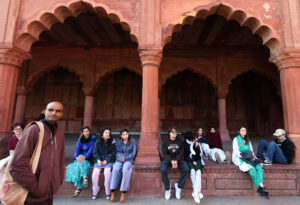
The man I talked to didn’t tell me his name; he asked me to just call him Brother. He was originally from the Netherlands but was now residing in Bordeaux, France. In response to my question, he told me that a big reason he was a monk was to serve others and to strive towards being a better person. This was a simple but wise answer. Serving something greater than yourself and performing work to accomplish enlightenment is a purpose that I find very noble. He then began explaining to me some Buddhist philosophies that he himself found very helpful and truthful. The first thing he taught me was the benefit of shedding all dogma. He explained that dogma is a preconceived idea about something. It is something that the mind uses to identify objects, beings, and concepts. But this is not taking things for how they really are. He used the example of a tree. When one encounters a tree, it is easy to look past it; it is just like any other tree. No, every tree holds a unique personality and artistic beauty. Letting what you are perceiving in the moment into your mind and affect your feelings can heighten your happiness. He told me to listen to the birds in the distance, which I had been hearing all morning but had tuned them out until then. This practice brought me into the moment, finding happiness by making the little things bigger than they seem.
He also talked to me about how returning to the simplest, purest form of yourself is the ultimate goal of bliss in Buddhism. He spoke about how many people are concerned about what they can gain by obtaining material things and other satisfactions. However, the true self has been within you all along, in your soul. It is a matter of stripping yourself of your dogma, what you believe yourself to be. He taught me how simple life should be, but also how vast a moment is. The way in which our mind views life around and within us is a changeable thing. When we practice patience and perception, the concept of happiness can change altogether.
You must be logged in to post a comment.